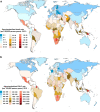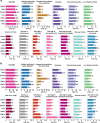Low- and middle-income countries demonstrate rapid growth of type 2 diabetes: an analysis based on Global Burden of Disease 1990-2019 data
- PMID: 35587275
- PMCID: PMC9118183
- DOI: 10.1007/s00125-022-05713-6
Low- and middle-income countries demonstrate rapid growth of type 2 diabetes: an analysis based on Global Burden of Disease 1990-2019 data
Abstract
Aims/hypothesis: The study aims to quantify the global trend of the disease burden of type 2 diabetes caused by various risks factors by country income tiers.
Methods: Data on type 2 diabetes, including mortality and disability-adjusted life years (DALYs) during 1990-2019, were obtained from the Global Burden of Disease Study 2019. We analysed mortality and DALY rates and the population attributable fraction (PAF) in various risk factors of type 2 diabetes by country income tiers.
Results: Globally, the age-standardised death rate (ASDR) attributable to type 2 diabetes increased from 16.7 (15.7, 17.5)/100,000 person-years in 1990 to 18.5 (17.2, 19.7)/100,000 person-years in 2019. Similarly, age-standardised DALY rates increased from 628.3 (537.2, 730.9)/100,000 person-years to 801.5 (670.6, 954.4)/100,000 person-years during 1990-2019. Lower-middle-income countries reported the largest increase in the average annual growth of ASDR (1.3%) and an age-standardised DALY rate (1.6%) of type 2 diabetes. The key PAF attributing to type 2 diabetes deaths/DALYs was high BMI in countries of all income tiers. With the exception of BMI, while in low- and lower-middle-income countries, risk factors attributable to type 2 diabetes-related deaths and DALYs are mostly environment-related, the risk factors in high-income countries are mostly lifestyle-related.
Conclusions/interpretation: Type 2 diabetes disease burden increased globally, but low- and middle-income countries showed the highest growth rate. A high BMI level remained the key contributing factor in all income tiers, but environmental and lifestyle-related factors contributed differently across income tiers.
Data availability: To download the data used in these analyses, please visit the Global Health Data Exchange at http://ghdx.healthdata.org/gbd-2019 .
Keywords: DALYs; Death; Population attributable fraction; Type 2 diabetes mellitus.
© 2022. The Author(s).
Figures



Similar articles
-
The global burden of disease attributable to high body mass index in 195 countries and territories, 1990-2017: An analysis of the Global Burden of Disease Study.PLoS Med. 2020 Jul 28;17(7):e1003198. doi: 10.1371/journal.pmed.1003198. eCollection 2020 Jul. PLoS Med. 2020. PMID: 32722671 Free PMC article.
-
The global burden of disease attributable to ambient fine particulate matter in 204 countries and territories, 1990-2019: A systematic analysis of the Global Burden of Disease Study 2019.Ecotoxicol Environ Saf. 2022 Jun 15;238:113588. doi: 10.1016/j.ecoenv.2022.113588. Epub 2022 May 5. Ecotoxicol Environ Saf. 2022. PMID: 35525115
-
The global burden of type 2 diabetes attributable to high body mass index in 204 countries and territories, 1990-2019: An analysis of the Global Burden of Disease Study.Front Public Health. 2022 Sep 9;10:966093. doi: 10.3389/fpubh.2022.966093. eCollection 2022. Front Public Health. 2022. PMID: 36159296 Free PMC article.
-
Global, regional, and national burden of 12 mental disorders in 204 countries and territories, 1990-2019: a systematic analysis for the Global Burden of Disease Study 2019.Lancet Psychiatry. 2022 Feb;9(2):137-150. doi: 10.1016/S2215-0366(21)00395-3. Epub 2022 Jan 10. Lancet Psychiatry. 2022. PMID: 35026139 Free PMC article.
-
The global, regional, and national burden of colorectal cancer and its attributable risk factors in 195 countries and territories, 1990-2017: a systematic analysis for the Global Burden of Disease Study 2017.Lancet Gastroenterol Hepatol. 2019 Dec;4(12):913-933. doi: 10.1016/S2468-1253(19)30345-0. Epub 2019 Oct 21. Lancet Gastroenterol Hepatol. 2019. PMID: 31648977 Free PMC article.
Cited by
-
Oral Health Knowledge, Attitudes and Practices of People Living with Diabetes in South Asia: A Scoping Review.Int J Environ Res Public Health. 2022 Oct 25;19(21):13851. doi: 10.3390/ijerph192113851. Int J Environ Res Public Health. 2022. PMID: 36360731 Free PMC article.
-
Global Burden of Dementia Death from 1990 to 2019, with Projections to 2050: An Analysis of 2019 Global Burden of Disease Study.J Prev Alzheimers Dis. 2024;11(4):1013-1021. doi: 10.14283/jpad.2024.21. J Prev Alzheimers Dis. 2024. PMID: 39044512 Free PMC article.
-
Exploring multimorbidity profiles in middle-aged inpatients: a network-based comparative study of China and the United Kingdom.BMC Med. 2023 Dec 13;21(1):495. doi: 10.1186/s12916-023-03204-y. BMC Med. 2023. PMID: 38093264 Free PMC article.
-
Investigating the temporal trends of diabetes disease burden in China during 1990-2019 from a global perspective.Front Endocrinol (Lausanne). 2024 May 10;15:1324318. doi: 10.3389/fendo.2024.1324318. eCollection 2024. Front Endocrinol (Lausanne). 2024. PMID: 38800477 Free PMC article.
-
Excess diabetes mellitus-related deaths during the COVID-19 pandemic in the United States.EClinicalMedicine. 2022 Dec;54:101671. doi: 10.1016/j.eclinm.2022.101671. Epub 2022 Sep 23. EClinicalMedicine. 2022. PMID: 36168320 Free PMC article.
References
-
- International Diabetes Federation (2019) IDF Diabetes Atlas, 9th edition. International Diabetes Federation, Brussels. https://www.diabetesatlas.org/en/resources/. Accessed 9 December 2020
Publication types
MeSH terms
LinkOut - more resources
Full Text Sources
Medical

